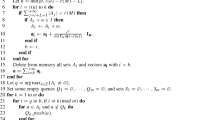Abstract
In this paper, we introduce the 1 − K robotic-cell scheduling problem, whose solution can be reduced to solving a TSP on specially structured permuted Monge matrices, we call b-decomposable matrices. We also review a number of other scheduling problems which all reduce to solving TSP-s on permuted Monge matrices. We present the important insight that the TSP on b-decomposable matrices can be solved in polynomial time by a special adaptation of the well-known subtour-patching technique. We discuss efficient implementations of this algorithm on newly defined subclasses of permuted Monge matrices.
Similar content being viewed by others
References
R.K. Ahuja, T.L. Magnanti, and J.B. Orlin, Network Flows: Theory, Algorithms, and Applications, Prentice Hall, Upper Saddle River: New Jersey, 1993.
Y.P. Aneja and H. Kamoun, “Scheduling of parts and robot activities in a two machine robotic cell,” Computers and Operations Research, vol. 26, pp. 297–312, 1999.
V.Y. Burdyuk and V.N. Trofimov, “Generalization of the results of Gilmore and Gomory on the solution of the traveling salesman problem,” Engineering Cybernetics, vol. 14, pp. 12–18, 1976.
R.E. Burkard, V.G. Deüíneko, R. van Dal, J.A.A. van der Veen, and G.J. Woeginger, “Well-solvable special cases of the traveling salesman problem: A survey,” SIAM Review, vol. 40, pp. 496–546, 1998.
R.E. Burkard, B. Klinz, and R. Rudolf, “Perspectives of Monge properties in optimization,” Discrete Applied Mathematics, vol. 70, pp. 95–161, 1996.
Y. Crama, V. Kats, J. van de Klundert, and E. Levner, “Cyclic scheduling in robotic flowshops,” Annals of Operations Research, vol. 96, pp. 97–124, 2000.
P.C. Gilmore and R.E. Gomory, “Sequencing a one state-variable machine: A solvable case of the traveling salesman problem,” Operations Research, vol. 12, pp. 655–679, 1964.
P.C. Gilmore, E.L. Lawler, and D.B. Shmoys, “Well-solved special cases,” in E.L. Lawler, J.K. Lenstra, A.H.G. Rinnooy Kan, and D.B. Shmoys, eds., The Traveling Salesman Problem: A Guided Tour of Combinatorial Optimization, ch. 4, pp. 87–143, John Wiley & Sons, Chichester, England, 1985.
N.G. Hall, H. Kamoun, and C. Sriskandarajah, “Scheduling in robotic cells: Classification, two and three machine cells,” Operations Research, vol. 45, pp. 421–439, 1997.
S.N. Kabadi, “Polynomially solvable cases of the TSP,” in G. Gutin and A.P. Punnen, eds., The Traveling Salesman Problem and its Variations, ch. 11, pp. 489–583, Kluwer Academic Publishers, Dordrecht, The Netherlands, 2002.
J.B. Kruskal, “On the shortest spanning subtree of a graph and the traveling salesman problem,” Proceedings of the American Mathematical Society, vol. 7, pp. 48–50, 1956.
M. Middendorf and V.G. Timkovsky, “On scheduling cycle shops: Classification, complexity and approximation,” Journal of Scheduling, vol. 5, pp. 135–169, 2002.
J.K. Park, “A special case of the n-vertex traveling-salesman problem that can be solved in O(n) time,” Information Processing Letters, vol. 40, pp. 247–254, 1991.
S.S. Reddi and C.V. Ramamoorthy, “On the flow-shop sequencing problem with no wait in process,” Operational Research Quarterly, vol. 23, pp. 323–331, 1972.
V.I. Sarvanov, “On the complexity of minimizing a linear form on a set of cyclic permutations,” Soviet Mathematics-Doklady, vol. 22, pp. 118–120, 1980.
S.P. Sethi, C. Sriskandarajah, G. Sorger, J. Blazewicz, and W. Kubiak, “Sequencing of parts and robot moves in a robotic cell,” The International Journal of Flexible Manufacturing Systems, vol. 4, pp. 331–358, 1992.
G. Steiner and Z. Xue, “Scheduling multi-component parts in robotic cells,” Working Paper, School of Business, McMaster University, Canada, 2002.
G. Steiner and Z. Xue, “Scheduling in reentrant robotic cells: Algorithms and complexity,” Journal of Scheduling, vol. 8, pp. 25–48, 2005.
Z. Xue, Shop Scheduling in Manufacturing Systems: Algorithms and Complexity, Ph.D. Thesis, McMaster University, Canada, 2004.
Author information
Authors and Affiliations
Corresponding author
Rights and permissions
About this article
Cite this article
Deineko, V.G., Steiner, G. & Xue, Z. Robotic-Cell Scheduling: Special Polynomially Solvable Cases of the Traveling Salesman Problem on Permuted Monge Matrices. J Comb Optim 9, 381–399 (2005). https://doi.org/10.1007/s10878-005-1778-8
Received:
Revised:
Accepted:
Issue Date:
DOI: https://doi.org/10.1007/s10878-005-1778-8




